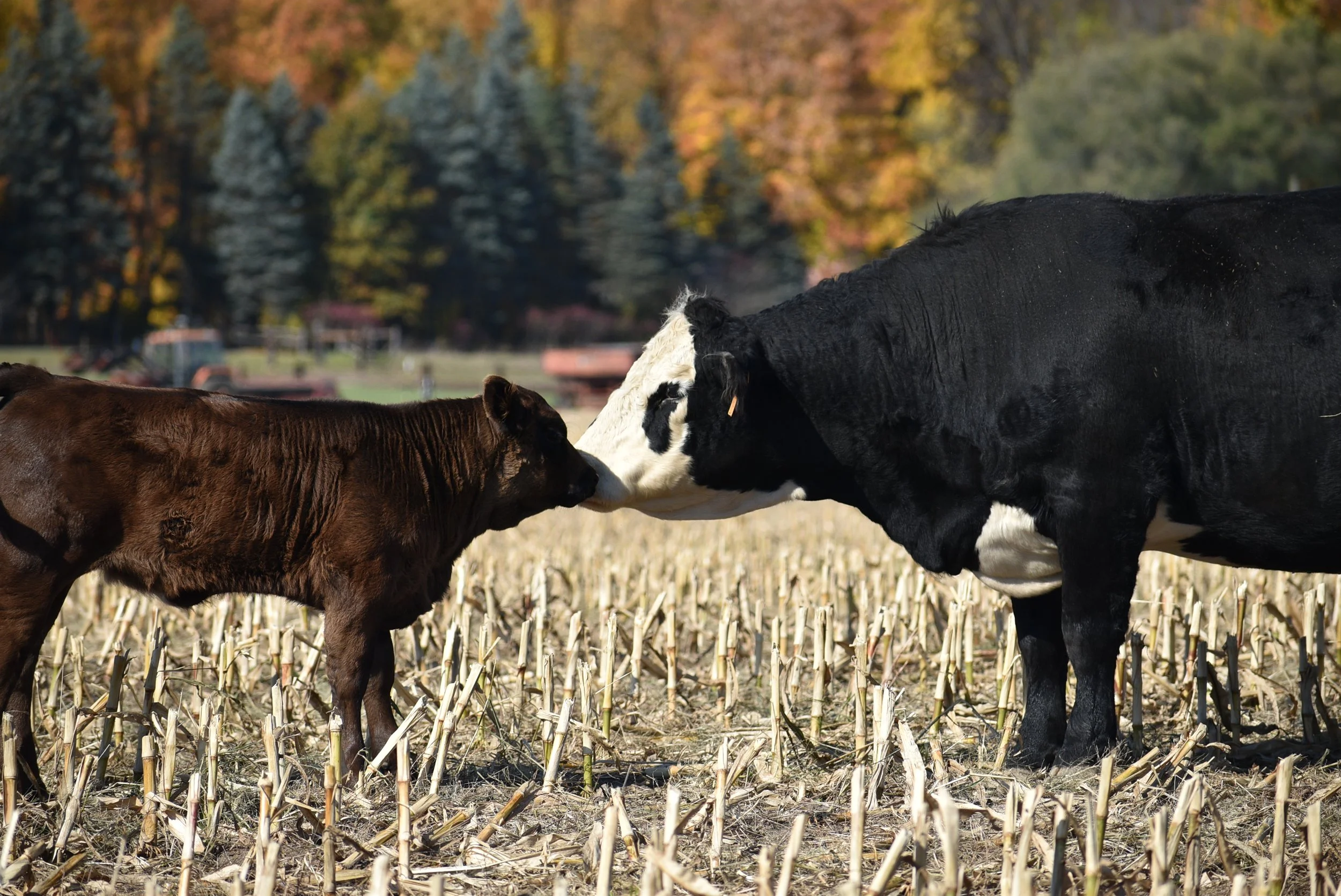You care about the way your beef is raised; as veterinarians, we understand the importance of raising healthy livestock. We use our veterinary education and our farming work ethic every day to provide the best care possible to our livestock. Here’s some insight into how we raise our steers.
Nutrition
The timeline looks something like this. Our calves are born. They are raised alongside their mothers out on pasture until about 8 months of age. They are then weaned from their mothers and transitioned onto a hay and protein pellet diet. After a couple of months of this, they are transitioned onto a diet that consists of corn, corn silage, hay, and protein pellet (a soy by-product) through the finishing period. Most of our steers finish between 14-15 months old.
Food for thought:
We get a lot of people asking about grass-fed beef. Grass-fed beef is a trendy niche market, and we certainly don’t disparage those that raise cattle that way. However, there are a couple of things to consider.
On our management side of things, we would not be able to raise the number of steers that we do if we grass-fed. Grass-fed steers take much longer to reach finished weight. As it currently stands, we raise crops on our tillable land and pasture the land that is not suitable for crops. Grass-feeding would require us to use our crop land for production of more forage, and then amount of beef we produce per acre would decrease. While sustainability is often not about maximizing production, it is imperative that we utilize our resources effectively. And our greatest resource is our soil.
Then there’s the customer side. It is well proven that the flavor and tenderness of beef is mostly attributed to the amount of marbling within the cut. Grass-feeding produces lean carcasses with little marbling, whereas grain-feeding maximizes marbling. Our grain-fed beef has yet to result in an unhappy customer.
Housing
Our feedlot is comprised of a three-sided barn, cement pad and dirt lot. The barn provides shade in the summer and shelter from wind, snow, and rain throughout the year. This barn is bedded with wood chips from fall through spring to keep the steers off the cold ground. The sizable cement pad keeps the steers high and dry out of the mud from fall through spring, and we scrape this cement regularly to keep it clean. In the summer, the steers tend to spend most of their time lounging out in the dirt lot.
Antibiotics
Our steers are very healthy in general. It is a rare day that we would reach for an antibiotic, maybe once every couple of years. However, such occasions do arise when an antibiotic is necessary, and this is typically a one-time administration. As veterinarians, our stance on this is very clear. We will never withhold an antibiotic for a curable disease. To do so is unethical. We have the knowledge to select the appropriate antibiotic for the given illness and follow all Beef Quality Assurance guidelines for administration. We usually attempt to put steers that receive antibiotics in our own freezer just because of the stigma. In the event this is not possible, we will always be transparent with our customers about what our steers have received.
Food for Thought:
Antibiotic stewardship is no joke. For the sake of human health and animal health we must be very responsible in protecting our antibiotics from resistance and also keeping antibiotic residues out of the food chain. Here’s some things to know.
It is illegal to use antibiotics for growth promotion purposes. Each antibiotic has a defined period in which an animal must be withheld from slaughter after administration. The USDA tests carcasses to monitor the amount of antibiotic residues entering the nation’s food supply; overall the number of positive tests is very low.
Implants
We never have, and never will use hormone implants in our cattle.
Food for thought:
Hormone implants are little estrogen tablets that are implanted in the ear. They are proven to increase both growth rates and feed efficiency. The increase isn’t huge, and usually pencils out to roughly $10-20 of increased profit per steer. To an outfit our size, what’s the point? It’s certainly not worth the stigma. But to a feedlot with 10,000 steers on feed, that could add up to an extra $200,000 profit.
Scientifically, the synthetic estrogen used is completely indistinguishable from endogenous estrogen. If you were to take a 3 once serving of steak, there would be 1.3 nanograms of estrogen in a natural steer and 1.9 nanograms of estrogen in an implanted steer. By comparison, an adult woman produces around 480,000 nanograms of estrogen per day. Or perhaps Google the estrogen activity of some of your favorite vegetables. The answer will likely be in the hundreds to thousands of nanograms.
As stated, we will never use hormone implants. But, as an industry trying to efficiently produce a protein source for a rapidly growing human population, maybe implants aren’t quite the devil they’re made out to be.
